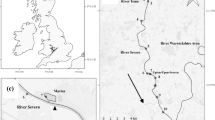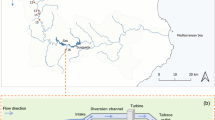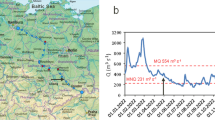Abstract
The effects of navigation on young-of-the-year (YOY) fish were investigated for the Danube River based on an integrative approach. During YOY growing season, wave height, wave frequency and water currents were recorded. Synchronously, fish drift and fish abundance of YOY were monitored in two distinct inshore nursery habitats—a gravel bar and a groyne field. The characteristics of vessel-induced waves were correlated to YOY-drift. In both habitats, an increase in drift densities during ship passages was observed. At the same time, assemblage composition and drift densities differed between habitat types. At the gravel bar, drift densities of larval cyprinids—representing many keystone species of the Danube—were higher during ship passages. In the groyne field, drift was low and percids dominated the YOY-assemblage along the shore. Banks with gentle slopes in the main channel seem to be particularly affected by vessel-induced wave wash. Precisely such habitats are often established within the scope of modern river restoration projects because they provide suitable nursery habitats for riverine fish species. Beside the positive effects on biota, the establishment of these habitats in navigable reaches may create problems for YOY-fish due to displacement effects induced by ship-generated waves.






Similar content being viewed by others
References
Adams, S. R., T. M. Keevin, K. J. Killgore & J. J. Hoover, 1999. Stranding potential of young fishes subjected to simulated vessel-induced drawdown. Transactions of the American Fisheries Society 128: 1230–1234.
Arlinghaus, R., C. Engelhardt, A. Sukhodolov & C. Wolter, 2002. Fish recruitment in a canal with intensive navigation: implications for ecosystem management. Journal of Fish Biology 61: 1386–1402.
Baranyi, C., T. Hein, C. Holarek, S. Keckeis & F. Schiemer, 2002. Zooplankton biomass and community structure in a Danube River floodplain system: effects of hydrology. Freshwater Biology 47: 1–10.
Barrett, J. C., G. D. Grossman & J. Rosenfeld, 1992. Turbidity-induced changes in reactive distance of rainbow trout. Transactions of the American Fisheries Society 121:437–443.
Copp, G. H., 1992. Comparative microhabitat use of cyprinid larvae and juveniles in a lotic floodplain channel. Environmental Biology of Fishes 33: 181–193.
Copp, G. H., J. M. Oliver, M. Penaz & A. L. Roux, 1991. Juvenile fishes as functional describers of fluvial ecosystem dynamics: applications on the River Rhone, France. Regulated Rivers: Research & Management 6: 135–145.
Flore, L., H. Keckeis & F. Schiemer, 2001. Feeding, energetic benefit and swimming capabilities of 0+ nase (Chondrostoma nasus L.) in flowing water: an integrative laboratory approach. Archiv für Hydrobiologie 135(2–4): 409–424.
Gaudin, P., 2001. Habitat shifts in juvenile riverine fish. Archiv für Hydrobiologie Supplement 135(2–4): 393–408.
Grift, R. E., A. D. Buijse, W. L. T. Van Densen & J. G. P. Kleinbreteler, 2001. Restoration of the river-floodplain interaction: benefits for the fish community in the River Rhine. Archiv für Hydrobiologie 135(2–4): 173–185.
Gutreuter, S., J. M. Vallazza & B. C. Knights, 2006. Persistent disturbance by commercial navigation alters the relative abundance of channel-dwelling fishes in a large river. Canadian Journal of Fish and Aquatic Sciences 63(11): 2418–2433.
Holland, L. E., 1986. Effects if barge traffic on distribution and survival of ichthyoplankton and small fishes in the Upper Mississippi River. Transactions of the American Fisheries Society 115: 162–165.
Huckstorf, V., W.-C. Lewin, T. Mehner & C. Wolter, 2010. Impoverishment of YOY-fish assemblages by intense commercial navigation in a large Lowland river. River Research and Applications 27(10): 1253–1263.
Karr, J. R., 1981. Assessment of biotic integrity using fish communities. Fisheries 6(6): 21–27.
Keckeis, H. & F. Schiemer, 2001. The ecology of the early life history stages of riverine fish: new perspectives in conservation and river management. Archiv für Hydrobiologie 113(2–4): 517–522.
Keckeis, H. & F. Schiemer, 2002. Understanding conservation issues of the Danube River. In Fuiman, L. A. & R. G. Werner (eds), Fishery Science: The Unique Contribution of Early Life Stages. Blackwell Publishing, Oxford: 272–288.
Keckeis, H., P. Frankiewicz & F. Schiemer, 1996. The importance of inshore areas for spawning nase Chondrostoma nasus (Cyprinidae) in a free-flowing section of a large river (Danube, Austria). Archiv für Hydrobiologie 135(1–4): 51–64.
Keckeis, H., G. Winkler, L. Flore, W. Reckendorfer & F. Schiemer, 1997. Spatial and seasonal characteristics of 0+ fish nursery habitats of nase, Chondrostoma nasus, in the River Danube, Austria. Folia Zoologica 46(Suppl. 1): 133–150.
Keckeis, H., M. Tritthart, E. Schludermann, C. Hauer, M. Liedermann, & H. Habersack, 2009. Analysis of habitat suitability for different fishzoenosis in a large river. In Universidad de Concepcion (ed.), The International Conference of Science and Information Technologies for Sustainable Management of Aquatic Ecosystems, 7th International Symposium on Ecohydraulics. ISBN: 978-981-08-2100-5.
Keckeis, H., E. Schludermann, D. Altmann, V. Bammer, B. Berger, S. Götsch, H. Hoyer & G. Rakowitz, 2010. Arbeitspaket B4e Biodiversität/Bioindikation – Fische. In Naturversuch Bad Deutsch Altenburg. Endbericht Premonitoring 2007. Messprogramm 2005–2008. Teil BIOTIK. Studie im Auftrag des Bundesministeriums für Verkehr, Innovation und Technologie und der viadonau: pp. 681–897. [in German].
Killgore, K. J., S. T. Maynord, M. D. Chan & R. P. Morgan II, 2001. Evaluation of propeller induced mortality on early life stages of selected fish species. North American Journal of Fisheries Management 21: 947–955.
Kottelat, M., 1997. European freshwater fishes. Biologia 52: 1–217.
Kucera-Hirzinger, V., E. Schludermann, H. Zornig, A. Weissenbacher, M. Schabuss & F. Schiemer, 2009. Potential effects of navigation-induced wave wash on the early life history stages of riverine fish. Aquatic Sciences 71: 94–102.
Lamouroux, N., H. Capra, M. Pouilly & Y. Souchon, 1999. Fish habitat preferences in large streams of southern France. Freshwater Biology 42: 673–687.
Maynord, S. T., 2005. Wave height from planning and semi-planing small boats. River Research and Applications 21: 1–17.
Maynord, S. T. & T. M. Keevin, 2005. Commercial navigation traffic induced shoreline dewatering on the upper Mississippi River: Implications for larval stranding.ENV Report 55 – Interim Report for the Upper Mississippi River – Illinois Waterway System Navigation Study. US Army Corps of Engineers.
Mazumder, B. S., N. G. Bhowmik & T. W. Soong, 1996. Turbulence in rivers due to navigation traffic. Journal of Hydraulic Engineering 119: 581–597.
McCune, B. & J. B. Grace, 2002. Analysis of Ecological Communities. MjM Software Design, Gleneden Beach, Oregon. 300 pp.
Mittelbach, G. G. & L. Persson, 1998. The ontogeny of piscivory and its ecological consequences. Canadian Journal of Fisheries and Aquatic Sciences 55(6): 1454–1465.
Pavlov, D. S., 1994. The downstream migration of young fishes in rivers: mechanisms and distribution. Folia Zoologica 43: 193–208.
Peňáz, M., 2001. A general framework on fish ontogeny: a review on the ongoing debate. Folia Zoologica 50: 241–256.
Persat, H. & G. H. Copp, 1990. Electric fishing and point abundance sampling for the ichthyology of large rivers. In Cowx, I. G. (ed.), Developments in Electric Fishing. Blackwell Scientific Publications Ltd., Oxford, England: 197–209.
Petts, G. E., 1985. Impounded Rivers: Perspectives for Ecological Management. Wiley, New York: 296 pp.
Pielou, E. C., 1975. Ecological Diversity. Wiley, New York.
Probst, W. N., S. Stoll, H. Hofmann, P. Fischer & R. Eckmann, 2009. Spawning site selection by Eurasian perch (Perca fluviatilis L.) in relation to temperature and wave exposure. Ecology of Freshwater Fish 18(1): 1–7.
Reckendorfer, W., H. Keckeis, G. Winkler & F. Schiemer, 1999. Zooplankton abundance in the River Danube, Austria: the significance of inshore retention. Freshwater Biology 41: 583–591.
Reckendorfer, W., R. Schmalfuss, C. Baumgartner, H. Habersack, S. Hohensinner, M. Jungwirth & F. Schiemer, 2005. The Integrated River Engineering Project fort he free-flowing Danube in the Austrian Alluvial Zone National Park: contradictory goals and mutual solutions. Large River Vol. 15(1–4)/Archiv für Hydrobiologie Supplement 155(1–4): 613–630.
Renkonen, O., 1938. Statistische ökologische Untersuchungen über die terrestrische Käferwelt der finnischen Bruchmoore. Annales Societatis Zoologicae-Botanicae Fennicae Vanamo 6: 1–231.
Schaefer, D. J., E. E. Herricks, D. E. Leake & T. M. Keevin, 1992. Development of a plan of study to evaluate the biological risk of increased navigation traffic on the Mississippi River. The Environmental Professional 14: 248–256.
Schiemer, F., 2000. Fish as indicators for the assessment of the ecological integrity of large rivers. Hydrobiologia 422–423: 271–278.
Schiemer, F. & T. Spindler, 1989. Endangered fish species of the Danube River in Austria. Regulated Rivers: Research and management 4: 397–407.
Schiemer, F., T. Spindler, H. Wintersberger, A. Schneider & A. Chovanec, 1991. Fish fry associations: important indicators for the ecological status of large rivers. Verhandlungen der Internationalen Vereinigung für Limnologie 550: 1–5.
Schiemer, F., H. Keckeis, W. Reckendorfer & G. Winkler, 2001. The “inshore retention concept” and its significance for large rivers. Archiv für Hydrobiologie 135(2–4): 509–516.
Stoll, S., H. Hofmann & P. Fischer, 2010. Effect of wave exposure dynamics on gut content mass and growth of young-of-the-year fishes in the littoral zone of lakes. Journal of Fish Biology 76: 1714–1728.
Tritthart, M., 2005. Three-Dimensional Numerical Modelling of Turbulent River Flow using Polyhedral Finite Volumes. Wiener Mitteilungen Wasser-Abwasser-Gewässer No. 193. [in German].
Tritthart, M. & D. Gutknecht, 2007. Three-dimensional simulation of free-surface flows using polyhedral finite volumes. Engineering Applications of Computational Fluid Mechanics 1: 1–14.
Whitfield, A. K. & M. Elliott, 2002. Fishes as indicators of environmental and ecological changes within estuaries: a review of progress and some suggestions for the future. Journal of Fish Biology 61: 229–250.
Whittaker, R. H., 1952. A study of summer foliage insect communities in the Great Smoky Mountains. Ecological Monographs 22: 1–44.
Wilcove, D. S., D. Rothstein, J. Dubow, A. Phillips & E. Loscos, 1998. Quantifying threats to imperilled species in the United States. BioScience 48: 607–615.
Winkler, G., H. Keckeis, W. Reckendorfer & F. Schiemer, 1997. Temporal and spatial dynamics of 0+ Chondrostoma nasus, at the inshore zone of a large river. Folia Zoologica 46(Suppl. 1): 151–168.
Wintersberger, H., 1996. Species assemblages and habitat selection of larval and juvenile fishes in the River Danube. Archiv für Hydrobiologie 113: 497–505.
Wolter, C. & R. Arlinghaus, 2003. Navigation impacts on freshwater fish assemblages: the ecological relevance of swimming performance. Reviews in Fish Biology and Fisheries 13: 63–89.
Wolter, C., R. Arlinghaus, A. Sukhodolov & C. Engelhardt, 2004. A model of navigation-induced currents in inland waterways and implications for juvenile fish displacement. Environmental Management 34: 656–668.
Acknowledgments
This research was conducted in the monitoring task of the Integrated River Engineering Project on the Danube East of Vienna, funded by the European Union, the Austrian Ministry of Transport, Innovation and Technology, and via donau.
Author information
Authors and Affiliations
Corresponding author
Additional information
Guest editors: H. Habersack, S. Muhar & H. Waidbacher / Impact of human activities on biodiversity of large rivers
Rights and permissions
About this article
Cite this article
Schludermann, E., Liedermann, M., Hoyer, H. et al. Effects of vessel-induced waves on the YOY-fish assemblage at two different habitat types in the main stem of a large river (Danube, Austria). Hydrobiologia 729, 3–15 (2014). https://doi.org/10.1007/s10750-013-1680-9
Received:
Accepted:
Published:
Issue Date:
DOI: https://doi.org/10.1007/s10750-013-1680-9




